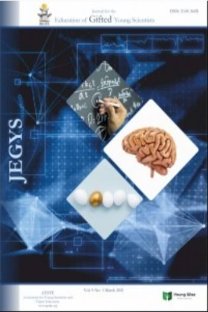Cognitive Level of Characters in the Indonesian Novel As a Source of Learning
This qualitative study aims at finding the level of cognitive of the characters in the Indonesian novel. The data in this study were collected through intensive reading based on Maryamah Karpov. The content is the characterizations belongs to the level of cognitive including memorizing, understanding, applying, analyzing, assessing, and creating. The process of data analysis is categorized into three stages, namely data reduction, data presentation, and conclusion. The result shows that the characterization of novel is identified as the level of cognitive of understanding, applying, analyzing, evaluating, and creating. In fact, the characterization also fills each indicator of cognitive level. Novel Maryamah Karpov is at a level of judging (C5) and creating (C6). The novel is classified into a high level of cognitive and is suitable as a source of learning in high schools. The drawing of recommendation based on this study is that teachers need to study the level of cognitive of any novel as a learning resource because the harmony between the level of cognitive and the level of intelligence of the students will have a significant effect.
Keywords:
Cognitive level, behavior of the characters, indonesian novel,
___
- Barter, N. (2016). Strategy Textbooks and the Environment Construct. Organization & Environment, 29(3), 332.
- Beauvais, C. (2015). The Mighty Child: Time and Power in Children’s Literature. John Benjamins Publishing Company (4th ed., Vol. 5). Amsterdam.
- Cartwright, K. B., Coppage, E. A., Lane, A. B., Singleton, T., Marshall, T. R., & Bentivegna, C. (2017). Cognitive flexibility deficits in children with specific reading comprehension difficulties. Contemporary Educational Psychology, 50, 33–44. https://doi.org/10.1016/j.cedpsych.2016.01.003
- Crane, N., Zusho, A., Ding, Y., & Cancelli, A. (2017). Domain-specific metacognitive calibration in children with learning disabilities. Contemporary Educational Psychology, 50, 72–79. https://doi.org/10.1016/j.cedpsych.2016.09.006
- Dore, R. A., Hassinger-Das, B., Brezack, N., Valladares, T. L., Paller, A., Vu, L., … Hirsh-Pasek, K. (2018). The parent advantage in fostering children’s e-book comprehension. Early Childhood Research Quarterly, 44, 24–33. https://doi.org/10.1016/j.ecresq.2018.02.002
- Eanes, R. (1997). Content area literacy: teaching for today and tomorrow. Texas: Delmar Publishers.
- Hansen, N., Jordan, N. C., & Rodrigues, J. (2017). Identifying learning difficulties with fractions: A longitudinal study of student growth from third through sixth grade. Contemporary Educational Psychology, 50, 45–59. https://doi.org/10.1016/j.cedpsych.2015.11.002
- Krathwohl, L. W. A. D. (2001). A Taxonomy for Learning, Teaching, and Assessing: A Revision of Bloom’s Taxonomy of Educational of Objectives. New York: Longman.
- Marni, S., Suyono, Roekhan, & Harsiati, T. (2019). Critical Thinking Patterns of First-Year Students in Argumentative Essay. Journal for the Education of Gifted Young Scientists, 7(September), 683–697.
- Marzano, R. J. (1992). A Different Kind of Classroom: Teaching with Dimensions of Learning. Alexandria, Virginia, USA: Association for Supervision and Curriculum Development (ASCD).
- Miles, B. M., Huberman, M. (1992) Analisis Data Kualitatif Buku Sumber tentang Metode-metode Baru. Jakarta: UIP. Riemer, N. (2019). Cognitive Linguistics and the Public Mind : Idealist Doctrines, Materialist Histories. Language & Communication, 64, 38–52. https://doi.org/10.1016/j.langcom.2018.09.002
- Shamionov, R. M., & Grigoryev, A. V. (2019). The Image of Socially Active Individual in the Representations of Student Youth.” International Journal of Cognitive Research in Science, Engineering and Education, 7(1), 15-20. DOI: https://doi.org/10.5937/ijcrsee1901015S
- Smith, B. (2002). Breaking through: college reading. New York: Longman.
- Vandenbroucke, L., Verschueren, K., Desoete, A., Aunio, P., Ghesquière, P., & Baeyens, D. (2018). Crossing the bridge to elementary school: The development of children’s working memory components in relation to teacher-student relationships and academic achievement. Early Childhood Research Quarterly, 42(August 2017), 1–10. https://doi.org/10.1016/j.ecresq.2017.08.004
- Vieluf, S., & Kerstin, G. (2019). Making Intercultural Learning in EFL Lessons Interesting The Role of Teaching Processes and Individual Learning Prerequisites and Their Interactions. Teaching and Teacher Education Journal, 79, 1–16. https://doi.org/10.1016/j.tate.2018.11.019
- Wollman-Bonilla, J.E. & Werchadlo, B. (1995). Literature Response Journals in a First - Grade Classroom. Language Arts, 72(8), 562-570.
- Zhdanko, A. (2019). Identification of Cognitive Manipulations that Have The Greatest Impact on Students in The Internet. International Journal of Cognitive Research in Science, Engineering and Education (IJCRSEE), 7(1), 35–42. https://doi.org/10.5937/ijcrsee1901035Z
- Başlangıç: 2013
- Yayıncı: Genç Bilge Yayıncılık
Sayıdaki Diğer Makaleler
Rosdiana ROSDİANA, İ Ketut BUDAYASA, Agung LUKİTO
İrina ANTONOVA, Zoya SNEZHKO, Yuliya YULİYA
Ahsan ABDULFATTAH, Supahar SUPAHAR
Pardimin PARDİMİN, Nyoman ARCANA, Didi SUPRİADİ
Saefuddin SAEFUDDİN, Fahyuddin FAHYUDDİN, Saleh SALEH
Muhamad YASİN, Durrul JAUHARİYAH, Madiyo MADİYO, Rika RAHMAWATİ, Fajri FARİD, İrwandani IRWANDANİ, Frendy Fitra MARDANA
Yulia PRAMUSİNTA, Punaji SETYOSARI, Utami WIDIATI, Dedi KUSWANDI
Winda RAMADİANTİ, Nanang PRİATNA, Kusnandi KUSNANDİ
Fatma SUKMAWATİ, Punaji SETYOSARİ, Sulton SULTON, Purnomo PURNOMO
